Trimble Westminster Building Project
When Trimble outgrew its Westminster facility, the company's decision to build a new campus provided the perfect opportunity to showcase all of its construction technologies, including machine control field products and software solutions.Published: May 2013
Author: Trimble Heavy Construction Division
Overview
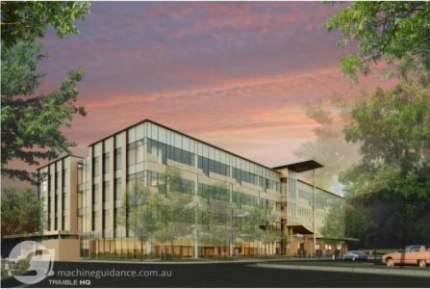
Overview
Outgrowing its current office facility in Westminster, Colorado, Trimble decided to build a larger campus across the street from their current building. The project is currently at Stage 1, is 15 acres and includes a 4-story office building 25 percent larger than the current facility with a large parking area and an equipment test area outside.
The project provides the unique opportunity to prominently showcase Trimble technologies within several industries, including surveying, heavy civil construction, and building construction. In total, the project teams will utilize more than 25 Trimble products and solutions throughout the project. In addition, the building project is pursuing Leadership in Energy and Environmental Design (LEED) Gold certification and proper documentation is being collected and filed to earn the designation.
This white paper will focus primarily on the site preparation and excavation work involved in construction of the Trimble Westminster Building project. Trimble Heavy Civil Construction solutions used on site include office software, machine control systems, and site positioning systems.
The earthworks and utility portions of the project included moving approximately 27,000 cubic yards of dirt and approximately 6,000 cubic yards of borrow material. The building pad was over-excavated by 5.5 feet below finished grade and backfilled in 1 foot compacted lifts.
The new 125,000 square foot facility is scheduled for completion May 2013.
Selecting a Contractor
When selecting a heavy civil construction contractor for the project, Trimble wanted to showcase a Trimble Connected Site® implementation.
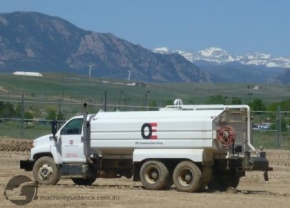
Selecting a Contractor (2)
Trimble assisted JE Dunn in choosing a local contractor, OE Construction Corp. to undertake the earthworks portion of the project. Individuals key to the success of the project from OE Construction included Chris Olson, owner of OE Construction Corp, Hemelindo Marquez "Lindo", Site Supervisor, and Mike Cassidy, OE GPS Specialist and Data Manager. While the OE team had used Trimble equipment and Business Center- HCE before the Trimble Westminster Building Project, they hadn't used the products to this scale in the past.
The machine fleet on the project consisted of: a Cat 14M Motor Grader, a Cat D6N Track Type Tractor, a Cat 627 Wheel-Tractor Scraper, a Cat 815 Soil Compactor, a Cat 345D Hydraulic Excavator, a Cat 966H Wheeled Loader, and Cat Skid Steer Loader. OE Construction agreed to equip all earthworks machines with Trimble SNM940 Connected Site Gateway hardware and grade control systems. The Trimble Connected Site Gateway brings the office and the machine together with remote machine support, and integrated data flows for machine and off-machine activities.
On this project and moving forward, Olson determined it was judicious to fully adopt 3D grade control not only for his 14M Grader but also his scraper. By making the investment in 3D grade control today, Olson is confident he will be able to realize a return on investment by streamlining operations across projects, less time and rework, and eliminating the need for manual staking and grade work.
They also captured information from their soil compactor, using the Trimble CCS900 Compaction Control System. In addition, they agreed to use VisionLink, Connected Community and Business Center - HCE office software from Trimble for the project. OE Construction Corp, is working with their regional Cat® and Trimble dealer, Wagner Equipment Co.
Spare
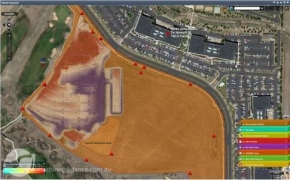
The Operations Plan
The operations plan called for stripping the site by approximately 0.5 feet and stockpiling the material in southeast corner. The team over-excavated the building pad, using cut material as fill on the south side of the building site. They also dug the foundations for the building, caissons and elevator shafts. OE Construction cut from the north side of the lot to fill the building pad and to complete the fill on the south side of the project.
The team imported borrowed material from their offsite borrow pit to compensate for the material shortage on site. The crews also carried out the utilities work for storm, sanitary and water, built the retaining walls, graded the parking area for the curb laying operations, trimmed the parking areas and roadways in preparation for the paving operations carried out by Asphalt Specialties Inc., who paved two out of three asphalt layers to seal the parking and road areas directly onto the compacted dirt. The building construction work was started by JE Dunn as soon as the pad area backfill was completed.
Connected Site Solutions
Office Software
Connected Community Powered by Trimble
The OE team adopted Connected Community to help facilitate and manage the entire Trimble Westminster Building project. It allowed Chris Olson, Mike Cassidy and others on the team to share all the project information using a unique, dedicated web site. By connecting people, devices and systems, Connected Community enabled OE to track project progress and site activity in real-time and online. Olson believes that by connecting the field and office with real-time information and allowing for syncing of information, his team was able to track project progress more efficiently and ensure all information was readily available to all team members on and off the site.
Business Center- HCE Powered by Trimble
Business Center - HCE is Trimble's office software for data preparation and takeoff. Mike Cassidy used Business Center - HCE to prepare and manage all design files for the Trimble project. The software provided effective field data management workflows with their Cat® AccuGrade Grade Control Systems, and Trimble Site Positioning Systems.
Civil, structural engineering and surveying firm Martin & Martin completed the civil design for the project. The team provided the contractor with a set of PDF plans and a 2.5D CAD DWG with elevated contours. As in many cases with design files, there was missing or insufficient information available to the contractor especially with respect to the development of a subgrade model. Mike Cassidy used Business Center- HCE's data preparation capabilities to make the design viable for construction and greatly improve the information used by the machines and controllers in the field.
At the start of the Trimble Westminster Building Project, Olson wanted his key machine operator Cassidy to learn Business Center- HCE and be able to create project models and manage the design files, not just for this project, but for the company's future construction projects. Working side by side with Trimble product experts Cassidy was trained and adopted the technology quickly. Soon he was able to use Business Center - HCE to import and clean up the 2D CAD design files received from the engineers.
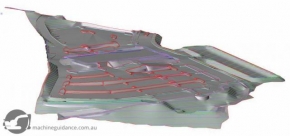
(2)
Cassidy used CAD linework, elevation labels (curbs and walls), contours for landscaping, and the plans to infill missing details. This included island walkway slopes as well as drainage swales. For subgrade adjustments, the finished grade model was adjusted for material thicknesses. Parking bays were designed to 6", heavy duty parking 7", concrete slabs 6", walkways 4", topsoil respread 4", riprap, and machine test areas 12".
One of the main challenges in working with the information provided from the engineering team is that there was insufficient information in the CAD files. For example, the building area sidewalks and drainage swales had too little information to know exactly how to model them. It was difficult to know what data to include and exclude to create a 3D model. Plus, some contours were incorrect and there were too many nodes in the contours. This created problems with subgrade surfaces. With insufficient and incorrect information in the design files, Business Center- HCE provided significant advantages.
For example, with Business Center- HCE Cassidy was able to drape the PDF document over the surface model to identify areas where more information needed to be interpolated from the plans. "The flow arrows in the TIN model are useful in checking on the surface water flows in the parking and concrete areas- using this process we can see how water will flow once the building is constructed," said Cassidy.
Cassidy learned some important takeaways from using Business Center- HCE on the Westminster Building project. First and foremost, having a solid project template to start proved to be extremely helpful. In addition, he believes it's imperative to read the plans in addition to the CAD files as they contain information to help solve most issues that arise. He also learned that the takeoff capabilities of the software should be used once the model was finalized using the data preparation functions for the greatest efficiency. "Get the data onto layers that you know and understand and assign them colors that you can readily identify and be consistent between projects- this will save a lot of time," said Cassidy.
In addition, progressing through a job logically and continually cleaning up designs and removing unwanted data early on in the process is also useful.
"I was so impressed that Cassidy came onto the project as a machine operator and with his willingness to learn and the usability of Business Center- HCE, he left as a Data Specialist and a Site Positioning System user." said Olson.
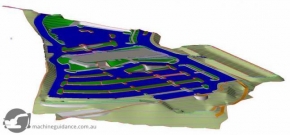
Earthworks Modeling
Earthworks Modeling
Cassidy created an earthworks model for grading work to be performed on the Trimble building site. He needed 3D models for excavation, subgrade, finish grade and a trench and pipe model for the utilities.
Finish grade model - This model shows the surface model for all of the finished surfaces on the project - roads, parking, walkways, islands, loading bays and all landscaping and retaining walls. The completed model provides a rendering of how the site should look when it's done. The provided 2D CAD files and PDF plans were imported into Business Center- HCE. The Business Center - HCE data preparation toolkit was then utilized to clean, sort and elevate the provided information, creating a digital 3D model. Three dimensional linework for curbs, walkways, islands, drainage swales, retaining walls, ponds, building foundations, landscaping and concrete loading bays are used to create a 3D surface model.
Mass earthworks and over excavation - Using the design specification documents and provided drawings, a subgrade adjusted model was created allowing for asphalt, concrete, topsoil and other construction material thicknesses. This is the model that was used in all of the earthmoving machines for the bulk earthmoving and excavation operations. In addition, the building needed to be over-excavated and backfilled with compacted material, so an over-excavation model was created to allow the machines to cut out the building area and backfill to grade.
Subgrade model - Here Cassidy adjusted the finished design surface model for grading operations. This included allowing for seven inches of asphalt in main traffic areas of parking lots, six inches of asphalt in actual parking spaces as well as 4-6 inches of concrete in island walkways and concrete pad areas for the loading bays and buildings.
Trench model - This model shows coordinated, location, depth, width, and size of pipes drainage inlets and manholes for the job site. Precision in this pipe and trench model is important to meet OSHA requirements for accurate cutting of trench slopes and for setting pipes and manholes or inlets at the correct elevations and slope.
"Engineers generally give us 2D CAD drawings or PDF files that we have to interpret and determine how to actually construct the project in the real world," said Cassidy. "With Business Center- HCE, in just three days we were able to build 3D models that accurately represent the project on the ground that were ready for all of our machine operations. This allowed us to identity problems-like areas of poor drainage / pooling or areas where the design had insufficient information provided for us to be able to accurately grade the site -before they actually happened, so we could rework our design accordingly."
Olson believes that with Business Center- HCE and machine control, his team was able to cut the excavation schedule on the Trimble Rockies Campus Project by more than 30 percent. "With such tight margins, anytime we can cut our schedule and move more dirt faster, we have a chance to make money on a project," said Olson. "Business Center - HCE helps us manage projects smarter."
"Having all of the models prepared and in the machines from day 1 allowed us to basically work anywhere on the jobsite at any time without having to wait for surveyors to come and set stakes so that we could start work. That flexibility adds up to huge time savings during the project because we can keep all the machines running productively all day" said Hermelindo Marquez, the OE supervisor on the project. "This is the first project that I have been on when I have had time to think. I even ran a machine on several occasions because I had time available and we needed work completed."
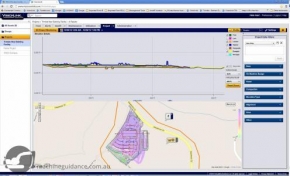
VisionLink Powered by Trimble
VisionLink Powered by Trimble
In addition to Business Center- HCE, the Trimble building project is also being managed with help from a web-based fleet, asset, and site productivity management tool called VisionLink. The VisionLink solution from Trimble integrates site productivity, material quantities, and materials movement with asset and fleet management. This gave Cassidy and the OE team a holistic view of the site and simplified the management of on-site operations. This allowed Cassidy to not only track and monitor machine location, usage, fuel and hours for scheduling, but also to see precisely how much dirt was being moved each day.
By centralizing data and monitoring the assets used on the project, OE was able to increase the productivity of its entire machine fleet. OE was able to monitor asset utilization and minimize idle times of machines, reducing machine runtime hours and unnecessary fuel burn.
In addition to using machines more efficiently, the team was also able to capture data for 3D project monitoring. In the future, Olson plans to use even more detailed information about cycles and loads for a holistic view of site operations. He's confident the software will provide greater insight into material quantities and materials movement to not only manage and make informed decisions about production efficiency but to also see continuously updated surface models based on machine activity.
The team was able to monitor and record 3D earthmoving, grading and finishing operations, create a near real-time 3D surface model, delivering both elevation and cut and fill maps to show progress towards completion.
With this information, Cassidy could make more informed decisions more quickly about equipment use and deployment.
"With VisionLink I could see and track surface models based on machine activity," said Cassidy. "Instead of spending time surveying every day, I was able to use VisionLink to see how much dirt was moved. We created almost real-time 3D surface models, elevation and cut and fill maps to show project progress."
Machine Control Systems
Cat AccuGrade GCS900 Grade Control Systems
Working alongside the Trimble and Wagner Equipment teams, Olson had several of his crewmembers trained to use 3D machine control.
During the six-week earthworks process, the Cat AccuGrade GCS900 Grade Control System was used on the dozer, excavator, motor grader and scraper at the Trimble building site. The machine control system utilized dual GNSS to measure the exact position, cross slope and heading of the blade for rough grading and mass excavation on steep slopes and complex design surfaces.
For the trenches and footing for the project, Olson used 3D machine control on its excavator. He cut trenches and trench slopes accurately to assist them with meeting OSHA requirements.
For bulk earthworks the dozer equipped with the grade control system displayed design information and live cut/fill indications in the cab for OE operators. The system gave OE operators real-time warnings for prevention of operation or movement into avoidance zones. It also collected as-built data as the machine cuts to grade.
For grading with the dozer, the machine control system allowed the OE operators to grade faster, without a single stake in the ground. The on-board control box determined the position of each tip of the blade and compared it to the design elevation to compute cut or fill to grade. The operators then used cut/fill data to drive the valves for automatic blade control (light bar indicators also provided visual guidance to the operator).
For finished grading work, with machine control the team was able to achieve finished grade to hundredths accuracy with fewer passes. Bulk excavation earthwork, utility trenching and foundations for the building were improved with the system because it measured the precise 3D position of the teeth of the bucket, turning the bulk earthmoving machine into a fine cutting and grading tool.
With his machines equipped with machine control and an SNM940, Cassidy was able to monitor and track the level of earthworks progress happening onsite through VisionLink.
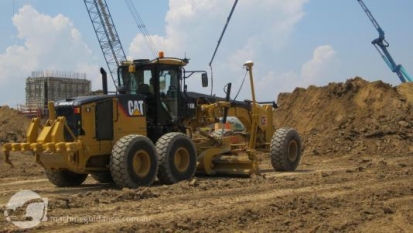
Left Image Grader
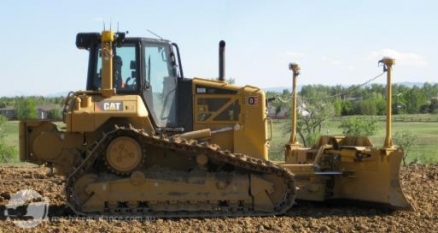
Image Right - Dozer
Site Positioning Systems
The OE crew provided a Trimble SPS882 GNSS Smart Antenna and Trimble Tablet running SCS900 Site Controller Software. The Trimble SCS900 Site Controller Software gave the OE team an easy-to-use graphical interface for grade checkers and project managers to do their jobs faster and more efficiently.
Trimble Tablet
Trimble Tablet
The Trimble Tablet is a handheld computer that allows construction professionals to make design changes in the field, connect to the office for on the spot approvals and communicate changes to field crews or machines. The Trimble Tablet runs the Windows 7 Operating System and can be used as a complete field computer.
With minimal training Mike Cassidy was able to quickly receive design changes, provide updates from the field, and deliver results back to the office for quick approvals. By incorporating a cellular modem, laptop capability, and controller into one rugged and compact package, the Trimble Tablet allowed Cassidy to connect his office to the building construction site.
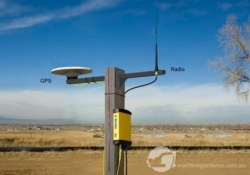
Base Station
Base Station
The Trimble SPS852 GNSS Modular Receiver was selected as the base station because it is ideal for semi-permanent or permanent setups, as well as construction rover applications.
With a modular and flexible design, the SPS852 base station was mounted on the current Trimble building. It broadcasted on 900MHz and piped corrections to the Internet Base Station Service (IBSS) server for cellular connection.
Establish Control For The Project
Establish Control For The Project
Cassidy used control coordinates established by professional survey firm Accurate EngiSurv. There were six permanent control points across the project. The site calibration was carried out by Cassidy and GPS calibration was checked in to 0.02' (~6mm) in 3D.
Using the SPS882, extremely accurate GNSS positions were taken at every control point and used to compute the site calibration for the project which matches the GPS coordinates with the local project coordinates; at the same time the process verifies that the surveyors control is correct before work starts.
Verify 2D Plans Match 3D Models
Verify 2D Plans Match 3D Models
Cassidy used the Trimble Tablet and SPS882 rover setup to collect measurements of the existing ground and build a surface model that could be used to verify the existing ground used by the engineer for the design process. The team verified that the design fit existing conditions and that estimated volumes were correct.
Site Verification Model
He also used the rover setup to measure in existing ground features that they would need to tie into during construction such as curbs on the road entry and exit to the parking lot and to existing storm, water and sewer utilities.
During earthworks operations, Mike used the Trimble rover to check the machines and monitor progress in the over-excavation areas and grading areas of the parking lot. On completion of an area of grading or a utility line installation, Mike used the rover to carry out as-built measurements to prove and record completion to the required tolerance. "Prior to using the Trimble Tablet we kept 3D models on a central computer in the office or onsite trailer," said Cassidy. "But we were rarely able to update shared models and files during construction planning or to identify problems during actual construction.
With the Trimble Tablet I can measure points, widths, and tolerances, and I can go back to the plans immediately to check the specifications from the field."
Connecting the Field and the Office
Connecting the Field and the Office
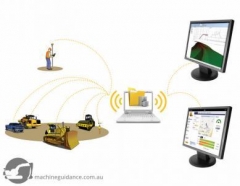
Trimble Connected Site
Cassidy also used the Trimble rover to review and edit designs, and easily access the same digital design data that is provided to the machines. He was also able to monitor real-time cut/fill information and check finished grade and laid material thickness against design elevations and tolerances.
"The Trimble Tablet and SCS900 gave me all the functionality I needed - like always-on connectivity and email, but also the ability to do things that would have taken multiple steps in the past," said Cassidy. "Like pulling up plans, submitting approvals, accessing as-built measurements, computing stockpile volumes, checking finished grade. Plus, the Trimble Tablet is rugged enough to perform in this hot, dusty environment that's exposed to all the elements."
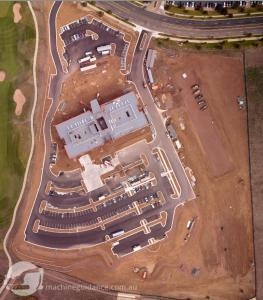
Conclusion
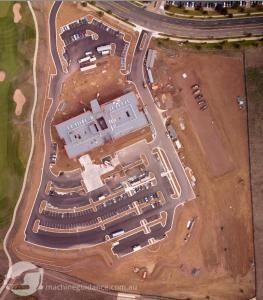
Conclusion (2)
During the six-week excavation phase of the Trimble Westminster Building project, Olson, Lindo, Cassidy and the entire OE project team achieved significant productivity gains with the Trimble Connected Site solution. The Trimble Heavy Civil Construction set of data preparation, asset management, and collaboration software provided the foundation for a more integrated and effective operation. The site positioning and machine control systems worked within this streamlined framework to provide a high-level of workflow integration that delivered significant improvements throughout the construction lifecycle.
Happy with the productivity gains enabled by Trimble technology, today the OE team has fully adopted 3D project design and management. Olson, Cassidy and other team members understand the benefits and they are confident running projects this way.
They have purchased the excavator and compactor systems from the project as well as a second Trimble base and rover system with the Trimble Tablet field computer. Rounding out its portfolio of products, OE now has eight 3D machine control systems as well as two seats for Business Center- HCE. Today, with diligent work from OE Construction Corp., JE Dunn, and supporting efforts from the paving contractor, the earthworks, grading, utility work and parking area of the Trimble Westminster Building Project is complete.
Credit
Trimble applies technology to make field and mobile workers in businesses and government significantly more productive. Solutions are focused on applications requiring position or location-including surveying, construction, agriculture, fleet and asset management, public safety and mapping. Learn more about Trimble Heavy Construction at www.trimble-productivity.com
Return to Articles

